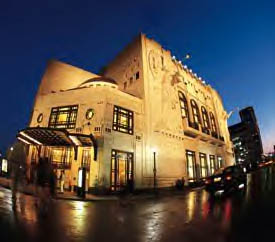A
heady brew of heritage tourism:
beer museums
At night,
the Brew Kettle Museum gleams behind glass, its copper dome illuminated
inside the rotunda of windows to attract passers-by.  Filled
with artifacts and memorabilia of brewing history through the ages,
the museum documents the rich history of the Miller Brewing Company
and its 90-year association with...Ft. Worth. Filled
with artifacts and memorabilia of brewing history through the ages,
the museum documents the rich history of the Miller Brewing Company
and its 90-year association with...Ft. Worth.
Yes,
among the dozens of beer museums that dot the globe is the Miller
museum found in Texas, where visitors to the plant's tour center and
gift shop may enter an annex to travel through "Miller Time"
for "history, relaxation, and shopping."
The Miller
Marketplace and Brew Kettle Museum is a good example of how many breweries
now turn to heritage tourism to promote their brands.
Miller
has plenty of company in displaying memorabilia of brewing dynasties
over the decades, mounted as historical exhibits.
The Boston
Beer Company maintains a pilot brewery and museum, while the Brewery
Museum at Burton-on-Trent, England, and the Czech Beer Museum, in
Plzen, are mostly underwritten by the former Bass Breweries PLC and
Pilsner Urquell respectively. Anheuser-Busch has subsidized a television
show on brewing history and keeps an historical archivist on staff.
There's
the Stiegl bier museum in Salzburg, Austria, the Greene King ale museum
in Bury St. Edmunds near Cambridge, UK, and closer to home, the Schell's
museum and gift shop in New Ulm, Minnesota.
But can
a beer museum operate independently, as proposed by the organizers
of Milwaukee's Museum of Beer and Brewing?
Actually,
a few comprehensive beer museums do thrive without a sole commercial
brewer's sponsorship. The Confederation of Belgian Brewers, a 300-member
trade organization, maintains the 500-year-old brewer's Guild Hall
as a museum on the Grand Place in Brussels, Belgium. Twenty years
ago, the brewers of Franconia in Bamberg, Germany (pop. 70,000), opened
a volunteer-run museum that draws just a few thousand visitors annually.
In 1996, the Museo de la Cervesa opened in Madrid, housing both a
tap-room and collection of 1930's European breweriana.
Back
in the States, the American Hop Museum documents the Pacific Northwest
hops industry, through exhibits mounted in an old warehouse in tiny
Toppenish, Washington. Supported by donations from both brewers and
hop growers, and staffed primarily by volunteers, the American Hop
Museum derives operating income from its large gift shop as well.
With an admission fee of just $2 per adult, and open only March through
October, this museum truly operates on a beer budget.
Milwaukee
has a hidden trove of breweriana, in the Haydock Collection.
For the
American Breweriana Association, which "advances the public knowledge
of brewing and brewing history," and other industry observers,
chief speculation concerns what portion of the legendary Haydock Collection
of brewing memorabilia will any independent beer museum be able to
borrow from the Miller Brewing Co. The now-defunct American Specialty
& Craft Beer division of Miller acquired the Haydock Collection
from Oldenberg Brewery in 1995.
Some
of the Haydock Collection, "about the top ten percent in terms
of quality and historical value," says the American Breweriana
Association, is ensconced in Ft. Worth at the Miller Brew Kettle Museum.
The Haydocks are now involved with the Museum of Beer and Brewing.
The Museum
of Beer and Brewing's new
board of directors includes: Frederick Gettleman, Gary Luther, Jerrold
Hilton, Jeff Platt, Jim Haertel, Marjorie Volke, Jim Kupferschmidt,
Paul Popsychala, Paul Bertling, Dave Keating, and Karl Strauss. Among
the proposed sites for the museum is the former Pabst brewery complex
in Milwaukee's downtown, permitting both casual dining on pub grub,
a full bar and historical edification through sampling real beer.
"It
certainly makes sense for Milwaukee to be a host city for a beer museum,"
says Gregg Smith, Idaho-based brewer, beer historian and author of
"Beer in America: the Early Years" (Siris Books, 1998).
He adds, "A sole brewery's sponsorship is not a requisite for
success." As a beer historian, Smith's  vision
of the ideal beer museum would encompass not just memorabilia and
collectibles such as labels, cans and signs, but "comprehensive
brewing education, working displays of brewery operations, and of
course, tastes of the region's representative brews." vision
of the ideal beer museum would encompass not just memorabilia and
collectibles such as labels, cans and signs, but "comprehensive
brewing education, working displays of brewery operations, and of
course, tastes of the region's representative brews."
Left:
Ernst Frankenberg, a former brewery worker with Sprecher Brewing Co.,
demonstrates the tapping of an old beer barrel at a recent benefit
for the proposed Museum of Beer and Brewing.
Tim
Ericson, head of the University of Wisconsin-Milwaukee Archives helped
to assemble pictorial archives representing the Gettelman, Schlitz,
Pabst, and Blatz breweries. "When the Oral History Association
of America had its national meeting in Milwaukee," recalls Ericson,
"the very first thing that everybody wanted to know about was
the city's brewing history."
Fortunately,
the Wisconsin State Historical Society is now working with the Museum
of Beer and Brewing, thanks to its new board of directors. This is
a sign of support and progress from at least one nonprofit that recognizes
the importance of heritage tourism.
Portions
of this article first appeared in the Business Journal of Milwaukee.
|